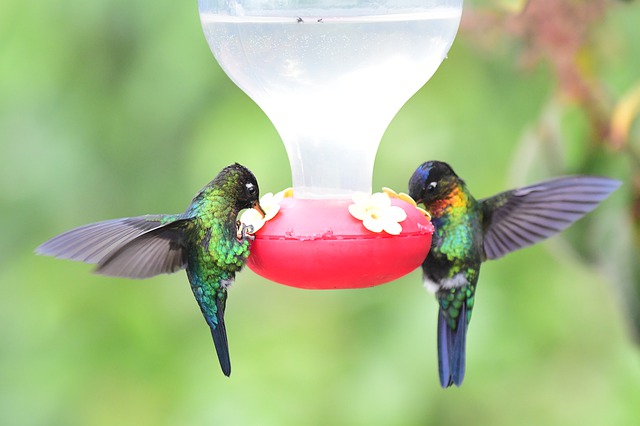How often do you change your hummingbird feeder?

Hummingbird nectar can either decompose or ferment, which means hummingbirds will try it once or twice, but then it gets bad and may not reappear.
You should turn your feeding nectar, even if it seems like it hasn’t given up a drop, naturally. During hot weather, change it every two days. In a temperate climate, once a week is fine.
To keep hummingbird nectar from taking off badly, you’ll want to position your feeder in an area with a mixture of daylight and shade throughout the day. If the daylight is too intense, the nectar can heat up and decompose or ferment in just a few hours.
Having said that, keeping the feeder completely in the shade is also not appropriate. When you do, it will be difficult for you to see the iridescent hues of your visitors.
If the feeder is cloudy or if you notice black debris, clean it immediately and arrange it well. Wash it a few times and let the feeder dry completely before refilling it as well. Mold life in a hummingbird feeder can be very dangerous for hummingbirds devouring their nectar.
Hummingbirds live in different parts of the world. They understand weather conditions and patterns just as you do, and it is important to enable them to remain safe in the environment in which they are distributed.
How to clean hummingbird feeders
The nature of hummingbird nectar makes keeping the feeder clean. Since nectar is a mixture of water and sugar, it is likely to be invaded and spoiled by microorganisms. Once this happens you will need to change your nectar but you also need to arrange your feeder as well. Doing so protects that your feeders aren’t just diverting those microorganisms to the next batch of nectar.
If mold, bacteria, and these other organisms build up a lot, it can make your hummingbird guests sick, and the birds can be decimated by eating that terrible nectar.
How to clean a hummingbird feeding bottle
Although hummingbird feed bottles come in a huge variety of shapes, they can all be arranged in the same way. Begin by washing the bottle and then recovering it with warm, soapy water. Wipe that and then use the bottle brush to wipe the inside. Once it’s clean, rinse it and scoop it up with fresh nectar. Don’t neglect to wipe the maximum amount of the bottle, too.
How to clean a hummingbird feeding base
The floor of each hummingbird feeder can be blasted separately with a soft pull. Once this is done, use a bottle brush to wash the inside and all corners and hollows with warm, soapy water. Furthermore, wash any saddles and outdoors. Some Top Fill Hummingbird feeders have an extra O-ring washer within the softer percentage of the base. You have to get rid of that to rank as well. Just remember to run it down the same path if it happens by mistake, you will not be eligible to re-seal the floor covering.
How to clean hummingbird feeders
Studying this we found a lot of quarrelsome data. Some people proclaim the soap was gentle, and some argue that soap should be banned and only vinegar should be used. We think the important thing is to discover something that will be easy for you to tolerate. Consistent cleaning is key. We agree to wash the soap thoroughly every time you restore the feeder, soaking in vinegar or bleach as a more frequent cleaning or if you spot a lot of difficulties with mold and mildew.
conclusion
Whether you make your own nectar or not, keeping your nectar feeder clean is of paramount importance. How often should you arrange hummingbird feeders? Between 1-6 working days on outside temperature. The hotter it is outside, the more you need to tidy up the feeder and bring out fresh nectar to avoid spoilage, mold and bacteria growth.



